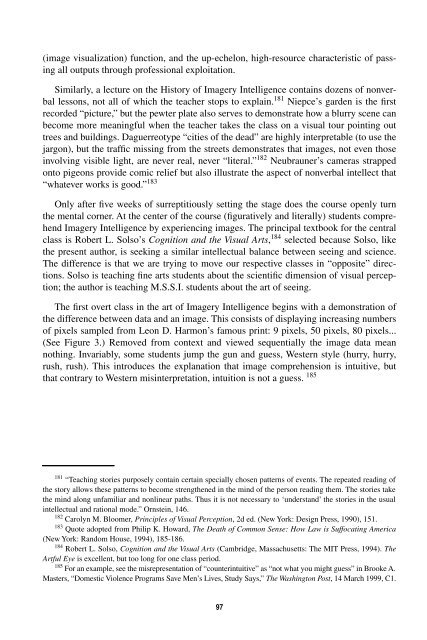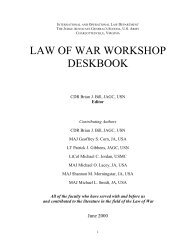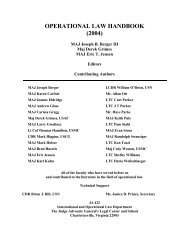learning with professionals - Higgins Counterterrorism Research ...
learning with professionals - Higgins Counterterrorism Research ...
learning with professionals - Higgins Counterterrorism Research ...
You also want an ePaper? Increase the reach of your titles
YUMPU automatically turns print PDFs into web optimized ePapers that Google loves.
(image visualization) function, and the up-echelon, high-resource characteristic of passing<br />
all outputs through professional exploitation.<br />
Similarly, a lecture on the History of Imagery Intelligence contains dozens of nonverbal<br />
lessons, not all of which the teacher stops to explain. 181 Niepce’s garden is the first<br />
recorded “picture,” but the pewter plate also serves to demonstrate how a blurry scene can<br />
become more meaningful when the teacher takes the class on a visual tour pointing out<br />
trees and buildings. Daguerreotype “cities of the dead” are highly interpretable (to use the<br />
jargon), but the traffic missing from the streets demonstrates that images, not even those<br />
involving visible light, are never real, never “literal.” 182 Neubrauner’s cameras strapped<br />
onto pigeons provide comic relief but also illustrate the aspect of nonverbal intellect that<br />
“whatever works is good.” 183<br />
Only after five weeks of surreptitiously setting the stage does the course openly turn<br />
the mental corner. At the center of the course (figuratively and literally) students comprehend<br />
Imagery Intelligence by experiencing images. The principal textbook for the central<br />
class is Robert L. Solso’s Cognition and the Visual Arts, 184 selected because Solso, like<br />
the present author, is seeking a similar intellectual balance between seeing and science.<br />
The difference is that we are trying to move our respective classes in “opposite” directions.<br />
Solso is teaching fine arts students about the scientific dimension of visual perception;<br />
the author is teaching M.S.S.I. students about the art of seeing.<br />
The first overt class in the art of Imagery Intelligence begins <strong>with</strong> a demonstration of<br />
the difference between data and an image. This consists of displaying increasing numbers<br />
of pixels sampled from Leon D. Harmon’s famous print: 9 pixels, 50 pixels, 80 pixels...<br />
(See Figure 3.) Removed from context and viewed sequentially the image data mean<br />
nothing. Invariably, some students jump the gun and guess, Western style (hurry, hurry,<br />
rush, rush). This introduces the explanation that image comprehension is intuitive, but<br />
that contrary to Western misinterpretation, intuition is not a guess. 185<br />
181 “Teaching stories purposely contain certain specially chosen patterns of events. The repeated reading of<br />
the story allows these patterns to become strengthened in the mind of the person reading them. The stories take<br />
the mind along unfamiliar and nonlinear paths. Thus it is not necessary to ‘understand’ the stories in the usual<br />
intellectual and rational mode.” Ornstein, 146.<br />
182 Carolyn M. Bloomer, Principles of Visual Perception, 2d ed. (New York: Design Press, 1990), 151.<br />
183 Quote adopted from Philip K. Howard, The Death of Common Sense: How Law is Suffocating America<br />
(New York: Random House, 1994), 185-186.<br />
184 Robert L. Solso, Cognition and the Visual Arts (Cambridge, Massachusetts: The MIT Press, 1994). The<br />
Artful Eye is excellent, but too long for one class period.<br />
185 For an example, see the misrepresentation of “counterintuitive” as “not what you might guess” in Brooke A.<br />
Masters, “Domestic Violence Programs Save Men’s Lives, Study Says,” The Washington Post, 14 March 1999, C1.<br />
97

















